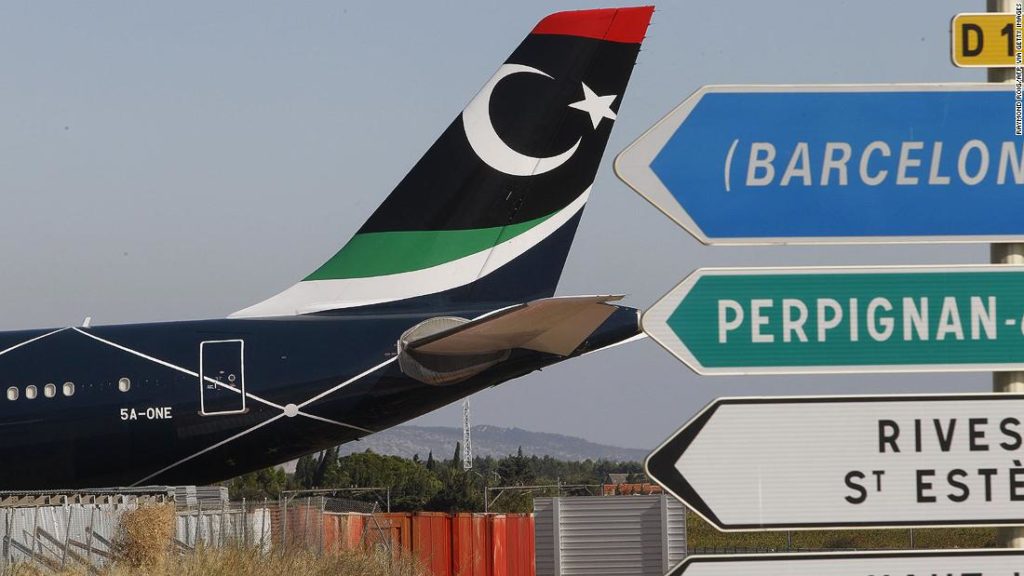Rebel forces had just taken control of the country’s airport and captured a major prize.
Short of capturing Gadhafi himself — Libya’s ousted leader would be killed by rebel forces weeks later — they had taken hold of one of his gaudiest symbols of power.
Bullets and shrapnel had riddled the fuselage of the four-engined Airbus A340-200 aircraft, but the interior was still intact.
Foreign journalists were soon invited on board to see it for themselves.
One after another, the innermost chambers of Libya’s presidential plane — by that point occupied by Kalashnikov-toting rebel militiamen — revealed their secrets: a hot tub, a private cinema, a mirror-lined master bedroom and more.
Although on the outside it looked like just another airliner of Libya’s flag carrier, Afriqiyah Airways, this extravagantly fitted aircraft was Gadhafi’s very own flying palace.
Refit, recycle, repurpose?
The fate of this luxurious presidential plane soon presented Libya’s new authorities with a quandary: What to do with an aircraft so closely associated with the excesses of its late dictator?
One option was to strip it of its VIP interior and turn it into a regular airliner.
This was not to be case with the Gadhafi plane but still, one thing was clear: Whatever final use it was given, the aircraft was in need of an extensive and thorough refit.
That’s why, in 2012, the former presidential aircraft, registration 5A-ONE, was flown to the facilities of EAS Industries (currently Sabena Technics), an aerospace maintenance and repair firm and Air France subcontractor based in Perpignan, in the south of France.
Unlike other airliners that were caught in the 2011 crossfire at Tripoli airport and had to be written off, Gadhafi’s A340 remained airworthy. The damage it suffered during the airport battle, though, was serious enough that the 900-mile trip to France had to be flown at a third of the normal cruising altitude and its landing gear couldn’t be retracted at all.
Lawsuits and controversy
Once in France, the aircraft was repaired and repainted.
The old Afriqiyah “9999” livery, which commemorated the declaration of a resolution to establish the African Union on September 9, 1999, was soon gone, replaced by a new one sporting the Libyan flag.
By 2013, the aircraft was ready to fly again, but rather than entering commercial service, it was retained by the Libyan government for its own use.
A short-lived tour, because, with the security situation in Libya deteriorating, by March 2014, 5A-ONE was back in Perpignan.
This time, though, its arrival on French soil marked the start of an international judicial imbroglio which has kept Gadhafi’s Airbus grounded to this day.
Lawsuits and controversy seem to follow this airframe wherever it goes.
It was first delivered, in 1996, to Prince Jefri Bolkiah, the playboy brother of the Sultan of Brunei. The prince is said to have spent $250 million customizing it before selling it less than four years later, at a time when he was entangled in a judicial feud with his family over the use of state funds.
But, soon after, the A340 was back on the market and it is at this point that Gadhafi enters the picture. The Libyan leader finally acquired it in 2006 for $120 million.
This was the first of several high-profile legal cases linked to this aircraft.

In August 2011, a Libyan rebel sits in the cockpit of the A340 that already had amassed a colorful history.
PATRICK BAZ/AFP via Getty Images
Caught in crossfire
In the same year Gadhafi bought his Airbus, the Libyan government signed a deal with the Al Kharafi Group, a Kuwait-based conglomerate, to develop a seaside resort in Tajura, near Tripoli. It was not long before this deal started to go sour and, in 2010, it was canceled by the Libyan side.
This was to be but the first act of a complex legal dispute taking place in multiple jurisdictions that is still ongoing today. Gadhafi’s presidential plane was to be caught, again, in a crossfire — only this time it was of the legal rather than literal kind.
The Al Kharafi Group sued the Libyan state in France too, so when the A340 landed in Perpignan, they sought to have it impounded.
The claimants appealed and, as their case was slowly making their way up through the French legal system, the former presidential plane was racking up other sorts of liabilities.
By 2016 maintenance, repair and refitting fees had gone up to nearly €3 million, which made Air France a party in the judicial process too, adding an extra layer of complexity to the case. This amount is likely to have gone up since then, and this happens also in a context in which the market value of gas-guzzling, four-engined planes, like the 25-year old Libyan A340, has plummeted.
Nevertheless, it seems that the aircraft is still being maintained and looked after. In late 2020, local spotters observed its engines getting started, a regular procedure for aircraft kept in long-term storage, but are still airworthy.
At this stage, it is hard to tell what the future holds for what has come to be known as “Gadhafi’s jet”.
Coincidentally, it’s not the only presidential jet that has become a long-term resident at Perpignan. Two other African presidential jets, both Boeing 727s, of the governments of Benin and Mauritania respectively, are also in long-term storage at the French Catalan airfield.
And more recently, in January 2021, another presidential Airbus A340 paid a visit to the same facilities to undergo maintenance. This one, though, used by French president Emmanuel Macron, is not expected to remain long among the vineyards of Roussillon.
You may also like
-
Afghanistan: Civilian casualties hit record high amid US withdrawal, UN says
-
How Taiwan is trying to defend against a cyber ‘World War III’
-
Pandemic travel news this week: Quarantine escapes and airplane disguises
-
Why would anyone trust Brexit Britain again?
-
Black fungus: A second crisis is killing survivors of India’s worst Covid wave


